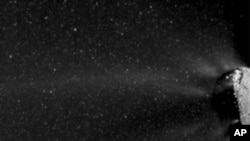Scientists know more about comets today than they did just two weeks ago, thanks to a NASA spacecraft that took photographs of a comet from a distance of only 700 kilometers earlier this month. The spacecraft is part of the Extrasolar Planet Observation and Characterization, and Deep Impact Extended Investigation, or EPOXI, mission.
Close-up pictures of the Hartley 2 comet taken this month revealed cosmic conditions that might be familiar to anyone who has ever spent a winter in a frosty town -- snow and ice.
The images made EPOXI mission scientist Pete Schultz's jaw drop. "To me this whole thing looks like a snowglobe that you've just simply shaken and watching it fly," he said.
The images researchers presented at a NASA news conference Thursday showed, for lack of a more precise term, snowballs that ranged from 3 to 30 centimeters in size.
A zoomed-in, high-resolution image shows brilliant white flecks, illuminated by the sun, against a dark background as the cloud of particles swirls around the comet.
Michael A'Hearn, the mission's principal investigator from the University of Maryland, provided an explanation for these particles. "That swarm of points around the nucleus [comet's core], those are not stars. Those are all chunks of ice," he said.
In fact, the pictures showed a cosmic snowstorm of sorts, created by carbon dioxide jets spewing out ice particles from the peanut-shaped comet's rocky ends. Meanwhile, sub-surface ice is evaporating at the comet's dry, smooth middle. The scientists say carbon dioxide appears to be key to understanding the different ways water escapes from Hartley 2's interior.
The Hartley 2 comet was close enough to NASA's Deep Impact spacecraft to give scientists the best extended view of any comet in history. The spacecraft used two telescopes with digital color cameras and an infrared spectrometer to gather detailed information as it flew past the icy, dusty comet.
Scientists say the spacecraft did not suffer any damage as it weathered this cosmic snowstorm, but they do believe it may have been hit by dust nine times in the 10 minutes it was closest to the comet, back on November 4.
The EPOXI mission's deputy principal investigator, Jessica Sunshine, is also from the University of Maryland. She explains that perhaps the craft was not harmed because the character of the snowy, icy particles is more wispy than, let's say, that of an ice cube. "What we're seeing are fluffy aggregates of very small pieces of ice and so they're akin more to maybe a dandelion puff that is empty air that can easily be broken apart [rather] than an ice cube, and that might explain why we didn't see any hits on the spacecraft," she said.
The spacecraft has collected 32,000 images of the Hartley 2 comet and it is still going. Scientists say that by the time the mission ends next week, it will have collected about 120,000 images.
Mission scientist Pete Schultz, of Brown University in the northeastern U.S., says there is plenty of data to mine from the best series of pictures of any comet ever.
"This is kind of like being in a car and with the signs just flying right by you, with the other ones in the distance, like the trees in the distance, staying pretty steady. So this gives you a sense that we are seeing things from different distances away, and the importance of this is that we can actually locate these objects and we might be able to tell where they are, with respect to the nucleus, in space," he said.
This is the fifth time that a spacecraft has been close enough to photograph a comet's core, so scientists are able to compare and contrast.
In fact, scientists used the very same spacecraft and instruments to gather information about the comet Tempel 1 back in 2005. During that mission, scientists actually crashed a probe into Tempel 1 and used the same recording equipment to gather information. Principal investigator A'Hearn says images show that Tempel 1 and Hartley 2 are very different comets. "When we excavated 10,000 tons of material from comet Tempel 1 five years ago, we looked really hard for the chunks of ice that we thought we would be excavating, and we didn't find any big chunks of ice. Most of the water came out as ice, but it was all in tiny micron-sized grains. So when we saw the images come down [of Hartley 2], even in real time in the raw data, and realized we had a cloud of snow around the nucleus, we were astounded, because it was so different from comet Tempel 1, and it's driven by a large excess of dry ice in at least one end of Comet Hartley 2," A'Hearn said.
And scientist Schultz, who says he was an amateur astronomer as a child and still remembers spotting two comets, says he cannot believe that the world can now see a comet close up. He says he is most excited to learn more about the particles surrounding the comet.
And Sunshine, who says her favorite comet was Tempel 1 until Hartley 2 came along, says she wants to learn how the features relate to the carbon dioxide jets and to compare the surfaces of her old favorite and new favorite comet.
Both Schultz and Sunshine say they are eager to get even closer to comets by hitting or landing on one.
The U.S. space agency says it is important to study comets because astronomers theorize they are part of a collection of gas, ice, rocks and dust that formed the outer planets of our solar system about 4.5 billion years ago. Some scientists say that comets originally carried some of the water and organic compounds that make up life on our planet.








